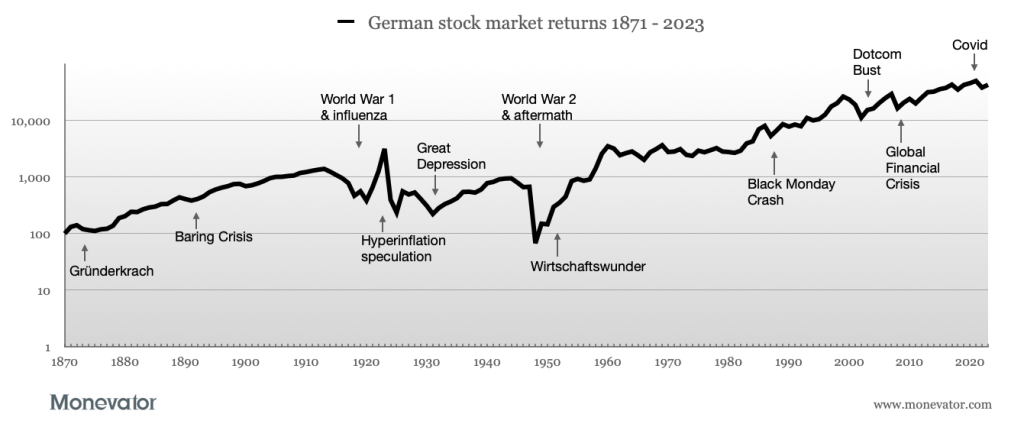
It’s hard not to feel a little head-rush when thinking about gold as an asset class. The yellow metal’s mythical status and cultural cachet is enough to trigger a reflexive “I WANTSSS IT” from your inner Gollum. But then – after briefly checking your eyes have stopped bulging – your rational side wins back control and asks: is gold a good investment?
Well, is it? The barbarous relic? Beloved of conquistadores, James Bond villains, and pirates with dodgy accents.
Moreover given virtually all the information out there is US-focussed, is gold a good investment for UK investors?
The Investor previously wrote a passable (his words) introduction to gold as an investment.
TI cited the common arguments in favour of ownership as:
• A portfolio diversifier due to gold’s low correlation with equities and bonds
• Inflation-hedging
• Insurance against financial collapse, social disorder, and hyperinflation
In this post, we’ll use GBP gold return data to test how well those claims stand up – and which are about as credible as alchemy.
But for our first stop, let’s examine gold’s historical track record, and whether that tells us anything about the precious metal’s future potential.
(Note: All returns quoted in this article are real returns – that is, they are adjusted for inflation.)
Gold investment returns
The chart below shows the growth of gold’s investment returns from 1900-2022:
Gold GBP data from The London Bullion Market Association and Measuring Worth.
September 2023.
Over 123 years, £1 of gold transformed into £2.74.
Which translates into a real annualised return of 0.82%.
Hardly worth travelling to the end of a rainbow for.
For comparison, over the same period the other main asset classes delivered:
• UK equities: 4.85%
• Gilts: 0.91%
• Cash: 0.45%
Also notice how the graph’s trend line is stoved in by some monster bear markets – especially the 1980-1999 beast. We’ll come back to that.
But there’s a snag we need to flag up immediately. Which is that, in truth, the returns history of gold is compromised by the heavy hand of State control.
Gold annual returns 1900-2022
The fingerprints of government are easier to see in the next graph:
Prices are effectively fixed up until 1968 by various forms of the gold standard, along with other restrictions including the closure of the markets due to the World Wars.
The free market is gradually reestablished between 1968 and 1975. After ’68, the market wakes up and gold returns oscillate wildly thereafter.
The real return fluctuations you see before then are mostly a consequence of inflation (especially during WW1 and WW2) and deflation (during the 1920s to early 1930s).
The gold price only otherwise unmoors when the pound devalues against the dollar (1949), and when Britain exits the gold standard (1919-1925, and from 1931 until the war begins in 1939).
For our purposes as budding gold investors, the track record before the dawn of the free market era is too distorted by conditions that no longer apply. They should probably be disregarded.
But naturally enough guillotining the data at any given particular point creates its own problems.
Goldie unlocks
The free market in gold thawed in stages from:
• 1968 – Gold bars are traded again on the New York market
• 1971 – The US ends the convertibility of the dollar to gold
• 1975 – US citizens are legally allowed to own gold again (a pleasure denied them since 1933)
The restoration of the market unleashed a shock wave of compressed change, as traders attempted to discover the real value of gold.
Thus three out of four of gold’s highest-ever annual returns medal from 1972 to 1974.
Notice how those years’ returns rise like skyscrapers above everything else on the chart (except the Burj Khalifa of results, 1979’s 69%.)
Gold returns in the free market era
Any of the three stages mentioned above (1968, 1971, or 1975) mark plausible starting points for gold’s modern track record.
Start digging from 1968 and we unearth a much more impressive growth story:
Data from The London Bullion Market Association, A Century of UK Economic Trends and FTSE Russell.
September 2023.
Gold turned £1 into £6.80 and notched an impressive real annualised return of 3.5% from 1968-2022.
The precious metal also ran golden rings around its rival diversifiers:
Data from Summerhaven1, S&P GSCI TR, BCOM TR, JST Macrohistory2, JP Morgan Asset Management, The London Bullion Market Association, Measuring Worth and FTSE Russell. September 2023.
1968-2022 real annualised returns (%)
• Equities: 5.7
• Gold: 3.5
• Gilts: 2.7
• Commodities: 2.7
• Cash: 1.1
However the yellow stuff’s performance is less than dazzling if we start from 1975 – and screen out the unrepeatable gold rush of 1972-1974.
1975 – 2022 real annualised returns (%)
• Equities: 8.4
• Gold: 1.5
• Gilts: 4.4
• Commodities: 0.9
• Cash: 1.3
The key takeaway here is that starting points matter. Not least because gold aside, the equities, gilts, and commodities results are all way off the historical averages you get from longer-term data.
Even 50-years worth of asset class returns can be misleading if that period is dominated by circumstances that aren’t likely to repeat in your investing lifetime.
For example, would you expect average future returns to look like 1914-1964, with its two World Wars and a Great Depression putting the boot in?
Hopefully not.
Golden ratios
When historical data is ambiguous, we can normally lean upon expected return models to help us form estimates of future performance that take current valuations into account.
So does a widely-respected expected return model exist for gold?
In a word: no. A few academics have taken a stab but there isn’t an accepted equation we can pull off the shelf to guide our thinking.
So what can we expect? What factors influence the gold price?
The greater fool theory
The greater fool theory suggests that when an asset has no intrinsic value, your hopes of making a profit rely on a ‘greater fool’ to buy it from you.
The question then is does gold have any intrinsic value?
Infamously, gold doesn’t offer compounding cashflow. Your golden nuggets do not pay out dividends or interest. You’re fully reliant on selling at a higher market price to make money.
The yellow element isn’t productive like a farm, a company – or even a gold mine.
Gold is just a lump of lifeless metal that some people think looks good dangling from their ears.
Industrial use accounts for less than 7% of worldwide demand, and is relatively price insenstive.
Jewellery makes up almost half of demand, though. It is somewhat influenced by the going rate for gold.
Load of old bullion
You’ve perhaps come across theories that an emerging middle class in India and China will drive demand for jewellery in coming decades?
But that story has been hanging around for years. Meanwhile, those two giant countries have enjoyed explosive economic growth – yet the gold tonnage required by the jewellery industry is no higher now than in the early Noughties.
Doubtless, if below-ground gold reserves ran out, that’d do wonders for your holding’s value. But a good third of gold is still entrusted to Mother Earth, relative to the total amount ever extracted.
And what if Jeff Bezos’ asteroid mining ship ever comes in? That’d dynamite your gold ETC for the foreseeable.
Mining for gold in space may sound like sci-fi. But think of it as an analogy for any technological breakthrough that increases the gold supply in the future.
Not to mention if the millennials of the ‘prepper’ persuasion ever do swap gold for Bitcoin en masse…
My point is that gold’s fate is obscured by a gauze of contemporary fables. If you want to remain dispassionate, then don’t get wedded to anyone’s alternative facts.
Fools like us?
The demand inelasticity of gold’s industrial and luxury goods customers means that much depends on your fellow investors. If the world supply of ‘fools’ for gold runs dry one day then your golden goose will be cooked.
Tellingly, the launch of gold ETFs3 during the Noughties does appear to have boosted the gold price.
According to the academics Erb, Harvey, and Viskanta:
The historical relationship between the real price of gold and the gold holdings of the two largest gold owning ETFs is shown for the period November 2004–July 2020.
As the gold holdings of these ETFs have risen, the real price of gold has risen. These two ETFs’ gold holdings represent the majority of demand for gold by ETF investors.
The authors go on to speculate that the emergence of these ‘massive passives’ could lead to:
…higher peaks and lower troughs for the real price of gold relative to the experience of the past.
Essentially, they’re saying that the financialisation of gold via ETFs and ETCs has led to it becoming a momentum play. Gold’s star rises when prices take-off and investors pile-on. But they’re as likely to head for the hills if prices sag.
He who smelt it…
Another hope lies in Cold War 2.0. If you’re a heavy subscriber to What the Government Won’t Tell You style newsletters, then you’ll know all about China’s attempts to diversify its central bank reserves away from the US dollar.
And actually, there is a nugget of truth to this one. If the figures are to be trusted then China’s gold reserves have doubled in 12 years. But then China is a mite larger than it used to be.
Feverish speculation about a gold-backed BRIC currency adds to the intrigue but – as a reason to be bullish – while I think this story is a crock, it ain’t made of gold.
Why gold can succeed when equities and bonds fall
In my view then, we have no fundamentals-based reason to expect a positive long-term return from gold. If you agree, then that could be reason enough to strike it from your investment shopping list.
But given the high level of uncertainty, we should also look at the other reasons why gold may be a good investment.
For instance, there’s strong evidence that gold works as a useful portfolio diversifier and can succeed when equities and bonds fall.
Here’s how gold responds when global equities take a hit:
Data from The London Bullion Market Association and MSCI.
September 2023.
The chart shows the performance of gold whenever World equities have suffered a 10%+ fall after 1970.
During 16 equity market slumps:
• Gold beat equities: 13 times
• Did was worse than equities: twice (plus one draw)
• Produced positive returns: eight times
Six out of 16 of those sell-offs were in bear markets:
Gold beat equities: six times
Gold produced positive returns: four times
So gold was really worth its weight when equities were in headlong retreat. Even the least of those bear markets inflicted a -30% knee-drop!
Using a different methodology,4 gold also bested UK government bonds in 11 out of 15 years when equities turned negative from 1970-2022.
And it helps too – when playing defence as a UK investor – that gold gets a bump when the pound falls against the dollar – as often happens during market strife.
All in all, the record shows that gold helps diversify risk in a traditional equity-bond mix.
Gold’s correlation to the other asset classes
Looking at a correlations asset class matrix can help us assess the diversification benefit of gold. An effective diversifier would register low positive or negative numbers against the other asset classes.
Indeed, one of the main arguments in favour of gold is that it enjoys low correlations to equities and bonds.
So let’s check if that really is the case:
Asset class returns correlations: annual returns 1968-2022 (inflation-adjusted)
Gold
UK equities
Gilts
Cash
Commodities
Gold
1
–0.30
-0.17
-0.1
0.44
UK equities
-0.30
1
0.38
-0.09
-0.26
Gilts
-0.17
0.38
1
0.22
-0.26
Cash
-0.1
-0.09
0.22
1
0.12
Commodities
0.44
-0.26
-0.26
0.12
1
Gold’s correlation to equities and bonds is staunchly negative. This means it has a reasonable chance of pitching up when they’re tumbling down.
Conversely, that also means gold regularly falls when those assets rise – which will most probably be the majority of the time.
But while gold may prove to be a drag on overall returns, its typically negative correlation to your investment mainstays can help reduce portfolio volatility.
That’s especially useful for retirees wishing to mitigate sequence of returns risk. And it’s why small gold allocations are often recommended in investment portfolio examples.
As an individual holding though, gold is as volatile as equities. It’ll be a wild and often difficult ride. Don’t put money into it if you only like good news.
What’s that you ask? Just how rocky can gold get?
Gold’s biggest market crash
While gold had a glittering 1970s it didn’t take long for the shine to come off. The gold market began to meltdown from February 1980. It kept sliding for another 19 years.
Losses peaked at -78%. Recovery took until July 2011. The whole saga lasted a brutal 31 years.
Of course, gold isn’t the only asset class that can torch wealth on a scale. Witness the UK’s biggest bond crash and worst stock market slump.
When people say investing is risky – they mean it.
Hopefully such nightmare scenarios won’t come to pass in our investing lifetime, but it’s still as well to be briefed on what can happen.
Golden fleeced
For another take on how gold can cut up rough, here’s its real drawdown chart:
The graph shows how far gold dropped from its previous peaks, adjusted for inflation. The white space on the 0% line represents the precious moments after recovery is achieved and before the next plunge.
As we can see, gold investors got little respite.
A couple of nasty bears even dumped on the golden age of the 1970s.
Then came the 1980 to 1999 rout.
Even if you held on through that – until July 2011’s breakeven point – you only had to wait a few months for the arrival of the next bear that October. Cue a -40% mauling that lasted until December 2015.
Not to worry though, the pandemic arrived to take every gold investor’s mind off it. The yellow metal duly clawed its way back into the recovery position in April 2020. A mere nine years to breakeven this time!
The point is don’t invest in gold for kicks. Its performance could leave you as regretful as King Midas.
But enough misery. What about the claim that gold is a good inflation hedge?
Is gold a good inflation hedge?
Sadly this is a myth that’s as persistent as El Dorado.
Take the -78% real return gold bust we’ve just talked about. The equivalent nominal loss was -46%. If gold was a good inflation hedge, it shouldn’t have shed any additional value in real terms.
Perhaps that was a temporary glitch? Well here’s gold’s one-year return plotted against UK inflation.
The connection looks almost random. And, sure enough, gold’s annual correlation to inflation is 0.025 from 1968-2022.
A score near zero means the relationship between the two metrics is almost non-existent. And that’s close to the pattern we see in the chart.
Finally, here’s the path of the real gold price during the free market era:
If inflation was the only thing that moved the gold price, then the yellow line in the chart above would be level. Gold would be a perfect short-term inflation hedge.
However the fact that the yellow line weaves around tells us that factors other than inflation have caused the price to move. After all, the nominal price minus inflation equals the real price.
This means, at the least, that gold is not a good inflation hedge – because it is non-inflationary factors that will mostly determine the return you receive.
Gold as disaster insurance
The Global Financial Crisis (GFC) was the one true Time of Darkness I’ve lived through when people really talked like the wheels could come off our decadent Western lifestyles. To me at least, the pandemic didn’t even come close for scares from a financial perspective.
And gold definitely was the ticket during the GFC. Gold ETCs were up more than 70% at the height of the crash.
People feared QE-induced currency debasement was on the cards. Some thought a hyper-inflationary spiral could follow.
Which meant gold melt-ups accompanied the post-GFC aftershocks, too.
Thankfully the cashpoints didn’t close and we didn’t have to brain each other in the streets for Chicken McNuggets. But some investors did still fear the system was teetering and sought refuge in gold.
Call that anecdotal data.
But what does the actual data show?
Well, hyperinflation is another catastrophe that gold is reputed to repel. And Erb and Harvey sift the evidence in their paper The Golden Dilemma. Yet the financial golden boys report:
…there is no reason to expect that the real gold return will be positive when a specific country experiences hyperinflation.
That said, they do think that gold may be less bad than paper assets when you’re paying for bread with a ten trillion note.
So then, is gold a good investment?
I’ve read study after study, and poured over the UK data, yet I’m still ambivalent about whether gold is a good investment.
For every feature, there’s also a gold bug.
While I’m attracted to gold’s negative correlation to equities and bonds, I shy away from its lack of intrinsic investing value.
It’d be okay if there was a reliable demand story that forecast a procession of fools buyers long into the future. But the decisive factor appears to be investor sentiment, and that cuts both ways.
I think an honest appraisal has to be a shrug of the shoulders. The fact is we could end up choking on gold dust as per the 1980s and 1990s. Or maybe we’ll enjoy golden years like the 1970s or Noughties.
On the other hand, those two decades were awful for equities (and the Seventies were appalling for bonds).
And that’s the point about gold – you buy it for its diversification potential. If everything else is going swimmingly then you’ll probably end up loathing your gold. But if it’s not…
Let’s delve more into the diversification side in the next post in this mini-series.
How much difference does an allocation to gold make to an equity-bond portfolio? Perhaps if the risk-adjusted returns are good enough, and gold confers a juicy rebalancing bonus, then the case will be clearer.
Take it steady,
The Accumulator
Bhardwaj, Geetesh and Janardanan, Rajkumar and Rouwenhorst, K. Geert, “The First Commodity Futures Index of 1933,” Journal of Commodity Markets, 2020.Òscar Jordà, Katharina Knoll, Dmitry Kuvshinov, Moritz Schularick, and Alan M. Taylor. 2019. “The Rate of Return on Everything, 1870–2015.” Quarterly Journal of Economics, 134(3), 1225-1298.Gold Exchange Traded Products are ETFs in the US and ETCs in Europe.Due to the lack of monthly gilt returns data
The post Is gold a good investment? appeared first on Monevator.



